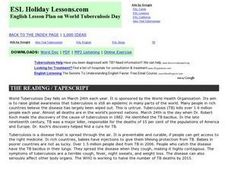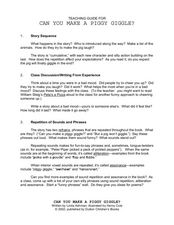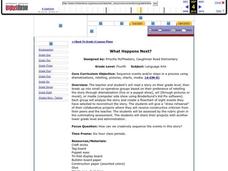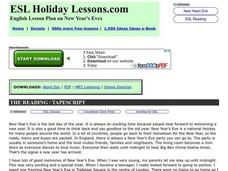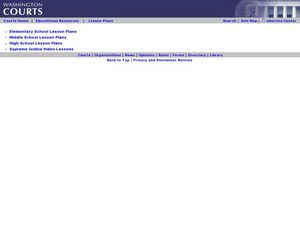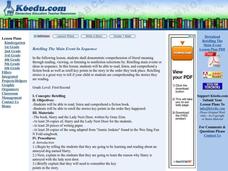Curated OER
Story Train
In this story sequencing worksheet, students will record the beginning, middle and ending of the book that they are reading on a graphic organizer in the shape of a train.
Curated OER
A Backward Day
In this writing worksheet, students think about what they did yesterday, but tell the events in backwards order from the events at the day's end to the beginning. Students read the story starter and finish the story.
Curated OER
Snowy Day
Students investigate the concept of reading comprehension while focusing upon the sequencing of a story. They read the story and use the cutouts included in the activity to put the story in order. Students also engage in a class discussion.
Alabama Learning Exchange
The Grouchy Ladybug
Learners listen to the book, "The Grouchy Ladybug" by Eric Carle and sequence the events in the story. Using a graph, they draw and color the animals that the ladybug meets next to the corresponding time from the story, and conduct...
Curated OER
THE LITTLE RED HEN - A TALE OF COOPERATION
Learners explore how much pleasure reading can bring, explain the concept of "story sequence", "re-tell" a story through art, and read other folktales.
Curated OER
Which Way???
In this story sequence worksheet, learners read a few paragraphs about a genie who granted wishes to a boy. Have your class number six story events to show the correct sequence. Kids can also learn the lesson "be careful what you wish for!"
Curated OER
World Tuberculosis Day
March 24th is annually recognized as World Tuberculosis Day. In this World Tuberculosis Day instructional activity, students complete activities such as word scramble, numbering passages, scrambled sentences, think=pair-share, and peer...
Curated OER
Teaching Guide: Can You Make a Piggy Giggle?
Students explore the book Can You Make a Piggy Giggle?. In this language arts lesson, students focus on a variety of aspects within the book. Students study the illustrations, listen for rhymes, and attempt the tongue twisters in the text.
Curated OER
Inca Culture and Society
Students read parts of text about Inca culture and society, put the text in the correct order, and discuss how they feel about the text. In this Inca lesson plan, students match Inca vocabulary to definitions.
Curated OER
Sequence Clue Words (Part 1)
Does your class know they can use sequence words such as, next, finally, after, and then to better understand the sequence of a story? First they discuss sequential order and sequence words, then they look for sequence words as they...
Curated OER
Sequence Clue Words (part 2)
If you've already discussed using sequence words to determine the sequence of events in a story, then a follow up lesson is definitely in order. They read the story, My Apron by Eric Carle and look at the sequence clue words such as...
Curated OER
My Family and Other Animals: Larry's Idea
In this my family and other animals: Larry's Idea worksheet, student answer 22 questions about the story, Larry's Idea, match characters, put events in order, and rewrite sentences.
Curated OER
Lesson Six: Story Elements/Inferring
Second graders practice the use of various story elements. In this story elements lesson, 2nd graders listen to the story All I See by Cynthia Rylant and look for the problem and solution in the story. They reread the book to create...
Curated OER
What Happens Next?
Fifth graders complete activities to help them sequence events in a story. For this sequencing lesson, 5th graders read a story and work in groups to retell the story by creating a flowchart of events to reconstruct. Students create...
Curated OER
New Year's Eve
For this New Year's Eve worksheet, students complete activities such as read the passage, match the phrases, fill in the blanks, choose the correct word, multiple choice fill in, correct the spelling, put text in correct order,...
Curated OER
Fourth Grade Language
In this language arts worksheet, 4th graders answer multiple choice questions about sequence of events, topic sentences, and more. Students complete 3 questions.
Curated OER
Exploring United States vs. Hirabayashi
Young scholars research the case of Gordon Hirabayashi vs. the United States. They research the case by completing a timeline activity and review the charges against him. Students review the entire case and discuss it from the...
Curated OER
Theatre Lesson Plan: Finding Your Way
Second graders identify story elements in familiar stories from their lives. In this story elements lesson, 2nd graders act out familiar activities by following directions. Students read a story and discuss the story elements....
Curated OER
Hickory Dickory Dock
Students use the Hickory Dickory Dock nursery rhyme to learn about rhyme, telling time, and preposition use. In this nursery rhyme instructional activity, students read the nursery rhyme daily and complete a Mother Goose quiz. Students...
Curated OER
Retelling Main Event in Sequence
Second graders practice retelling events from a fiction book. In this reading comprehension lesson, 2nd graders read Harry and the Lady Next Door and retell the main events of the story to a partner.
Curated OER
Retelling the Main Event in Sequence
Students identify the key events in a fiction book. In this literacy lesson, students read the book Harry and the Lady Next Door and work in pairs to discuss the main events of each chapter to develop a short summary.
Curated OER
Mr. Granger Exercises: Order of Events
In this story sequence worksheet, students read a passage about a man who begins an exercise regimen. Students place 8 events in the correct sequence by using the numbers 1-8.
Curated OER
Sequence Maker
In this story sequence worksheet, students read five sentences about getting up in the morning that are out of order. Students number them in the correct order and then write a paragraph using the sentences.
Curated OER
Which Way?
In this story events worksheet, students read a story about a child caught in a lightning storm. Students place six events in the correct sequence by using the numbers 1-6.








